9 Tutoring Strategies To Boost Student Learning & Motivation
Tutoring strategies are necessary for successful one-on-one or small group tutoring. Tutoring has a potentially transformative impact on student learning, but only if resources are used effectively and strategically.
If you’re looking to implement tutoring in your school, we’ve used our decade of experience providing math tutoring to list the 9 tutoring strategies key to successful learning.
What are tutoring strategies?
Tutoring strategies are practices that tutors use to:
- Develop tutees’ foundational skills
- Reteach core math concepts
- Provide guided practice in math skills
- Challenge students at their level
- Build self-confidence in math knowledge and skills
- Ensure that tutees are making progress
How are tutoring strategies different from whole class teaching?
Tutoring is targeted instruction in a small group or one-to-one setting. Tutoring may happen in the school setting, or at home. In this article, we use our expertise as school-based tutoring providers to focus on tutoring in schools but it may also be useful for parents considering private, home-based tutoring.
Some schools choose to provide group tutoring sessions. In group tutoring settings, tutees will work on the same skill together. This provides the opportunity to learn from each other, as well as the tutor.
However, group tutoring will require sensitive diagnostic assessment and grouping to ensure students share similar learning gaps and will all benefit from working on the same topics. Additionally, staff members running interventions will need more experience and training in managing groups of students, which is more challenging than one-on-one environments.
One-on-one sessions may be more appropriate for students who are farther below grade level or schools who want to provide highly personalized support. One-on-one tutoring provides the opportunity for tutors to address individual learning gaps and misconceptions. It can also help to support particularly shy or quiet students, or those with math anxiety, who may struggle in larger groups of students.
However it is delivered, tutors will work with tutees on targeted skills. Rather than moving through a set curriculum, tutors typically focus on student’s individual needs, addressing skills that the student needs to master or addressing achievement gaps.
Tutors must create partnerships with classroom teachers so that the tutor and teacher can work together to ensure that tutoring is having an impact.
Research supports tutoring as an effective intervention
High-quality tutoring has solid research supporting it as a way to produce positive learning for students (Nickow et al., 2020).
However, tutoring is not a silver bullet. Effective tutoring must involve careful planning, training, tutoring strategies and monitoring for the best impact on student outcomes.
According to research by the Poverty Action Lab, tutoring is most effective when it is:
- Provided at school, during school hours
- High-dosage tutoring (provided three times per week for 30 minutes per session)
- Delivered by trained teachers or tutors
- Provided one-on-one or in small groups, depending on the age of the student
- Used to address equity in education
In this article, we bring our decade of experience providing in-school math interventions to list the 9 key tutoring strategies to boost student learning and motivation.
Math Intervention Pack Number and Operations in Base 10
Support your 3rd-5th grade intervention students with number and operations in base 10 with these ready-to-go-math intervention packs
Download Free Now!9 tutoring strategies to boost student learning and motivation
Here are the key tutoring strategies to engage students in their learning, build motivation and promote progress. These tutoring strategies apply to all tutoring approaches, including group tutoring and one-on-one and online tutoring or face-to-face.
1. Build positive relationships
As a classroom teacher, you know that learning happens through interaction and relationships. The first thing that tutors should do is build a rapport with students. The most effective tutors will get to know tutees’ interests, preferences, and learning styles. A strong tutor-tutee relationship is the foundation for the learning process. As tutors and tutees work together, the relationship can become one of mentoring as well as teaching.
At Third Space Learning, tutors are provided with the student’s first name, age, and interests ahead of their first session together so that they can personalize tutoring sessions.
[include screenshot of product platform]
Teachers can also provide notes for the tutor about how best to work with each student and any educational plans (IEP or 504) or English as a Second Language (ESL) requirements.
2. Prepare lessons and resources
The best tutors come prepared with thorough lesson planning that addresses student needs and helps them reach the next level of math mastery. Tutors should also use available resources to enrich learning experiences.
At Third Space Learning, our math curriculum is developed by math teachers and pedagogy experts. All of our dedicated Curriculum Team are former teachers with decades of experience in the classroom and current knowledge of evidence-based teaching methods.
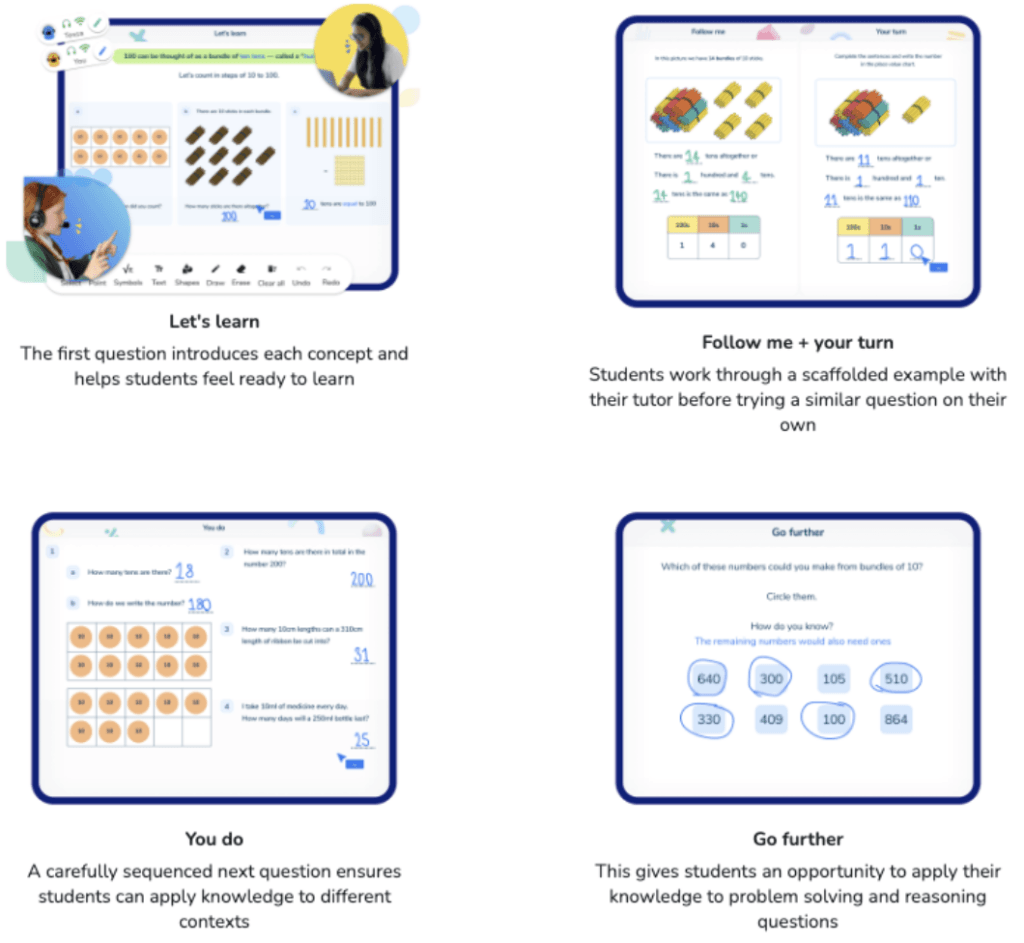
3. Use effective questioning techniques
The use of effective questioning drives each session and engages students in thinking. High-quality tutoring sessions involve interaction that engages students in thinking deeply about the material. For example, when a tutor prompts a student through a problem, they are building the tutee’s critical thinking skills, self-confidence, and metacognition.
Here at Third Space Learning, we provide extensive training to our tutors to ensure they ask the right questions, at the right time.
“We’ve been impressed by the range of questioning techniques that are used to keep the children engaged – the tutors gauge how the child is reacting to them during the lesson and adapt to them.”
Caroline Smith, Special education specialist
4. Check in and clarify
Tutors should also check in and clarify information frequently to ensure tutees understand the content. This is particularly helpful for students who are below grade level in math skills.
5. Build on prior knowledge
Tutors should access what students already know and make connections to new content. For example, a tutor can use active listening to identify which skills a student is confident with and provide the tutee with skills that are the next level of difficulty.
Third Space Learning lessons are structured to include an introductory slide to be used diagnostically. Tutors use questioning to understand a student’s current level, prior knowledge and any math misconceptions to tailor the lesson to their individual needs.
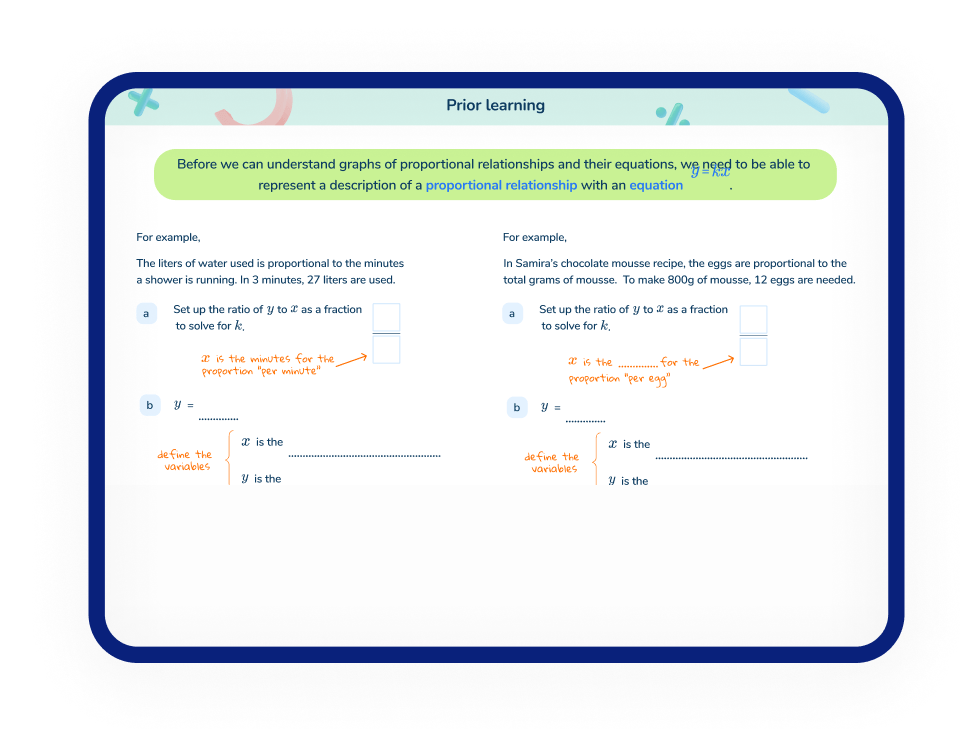
6. Use multiple modalities
Tutors engage tutees using various tools that have them writing, speaking, listening, and using math manipulatives. They may use a whiteboard, build with manipulatives or visuals, or work through a problem on the board with feedback. The idea is that they are engaged in active learning for the entire session.
Our online classroom is designed with math teaching in mind and allows tutors to use quick click buttons to generate mathematical symbols and shapes and get access to a library of support resources.
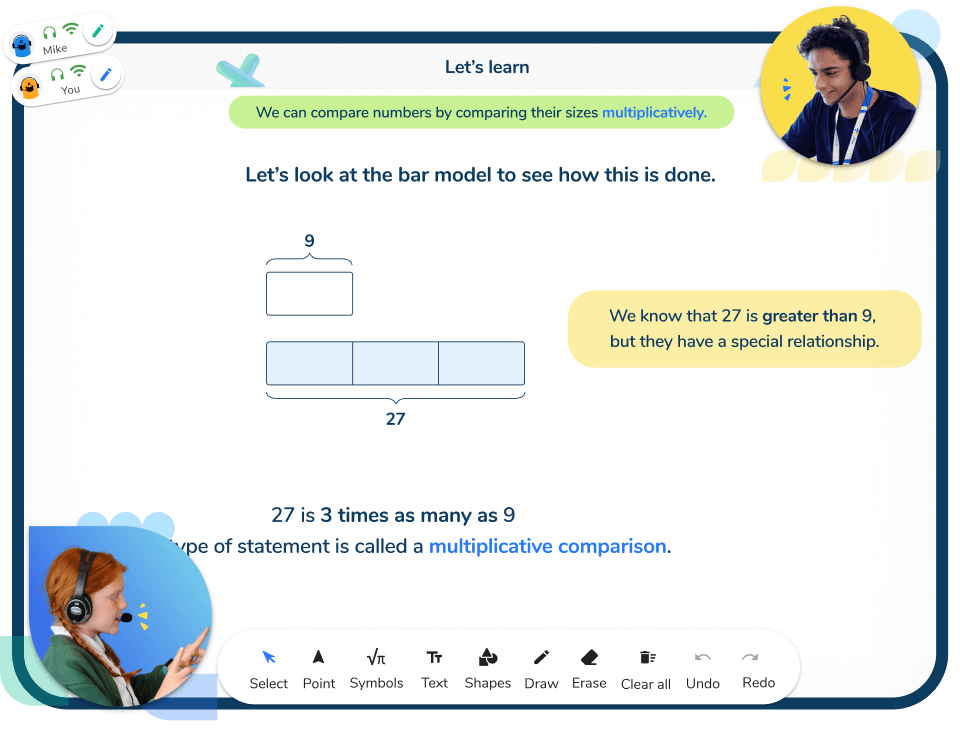
7. Develop metacognition
In math, students must apply the same process or skills to various problems. This requires the ability to think about what they are doing as they do it. Over time, when learners are able to identify what they are doing and why, they become more independent learners.
At Third Space Learning, the structure of our tutoring sessions aims to help students develop the confidence, math skills and metacognitive strategies to complete independent practice. Students are empowered to take on more challenging, problem-solving questions as their lessons progress.

8. Teach to generalization
Tutees will apply the same math skills in interventions and tutoring as in their main classroom, so tutors must explain and show students how the skills that tutees learn during a session apply to class time.
It is therefore important that the content of lessons and approach to teaching in tutoring sessions align with main classroom teaching. Here at Third Space Learning, we provide state standards-aligned lessons to ensure learning in tutoring sessions can be directly transferred to the classroom.

9. Monitor progress
Schools and tutors must be able to answer the key question: Is tutoring having an impact on student progress? Are students mastering the skills taught? And, if not, what is stopping them from mastering the skills? How should the tutor adjust tutoring to help the student reach the skill?
Progress monitoring is a key feature of effective tutoring. Here at Third Space Learning, after each tutoring session, teachers will receive a detailed report for each student showing topics covered, skills practiced and progress made. We also provide on-demand student progress reports in a printer-friendly format that can be used to inform whole classroom teaching or sent home to improve parental engagement.
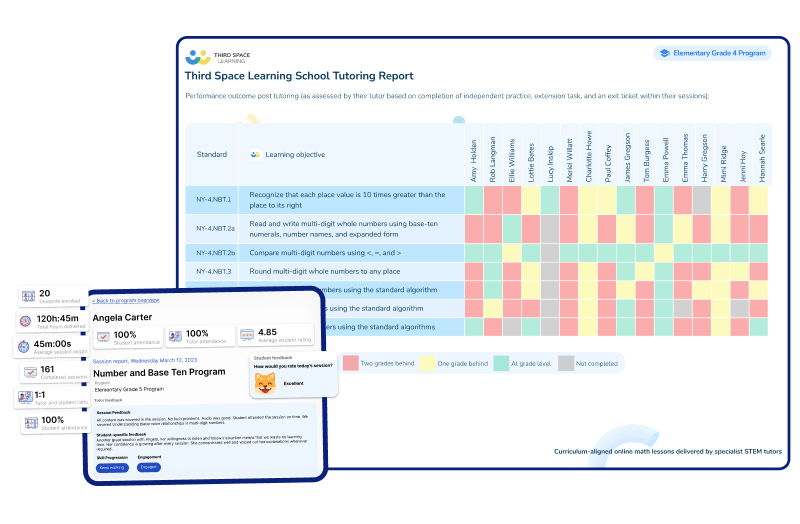
The key to successful tutoring: Tutor training
Research shows that tutors who have deep knowledge of math, teaching strategies and pedagogy are the most effective. Tutoring can be delivered by support staff and non-subject specialists but for the best impact, tutors should receive initial training and ongoing professional development.
Third Space Learning recognizes that the quality of tutor training is the most important factor in high-quality, impactful tutoring.
Third Space Learning tutors are screened not only for their knowledge in math but also their teaching and relationship-building ability.
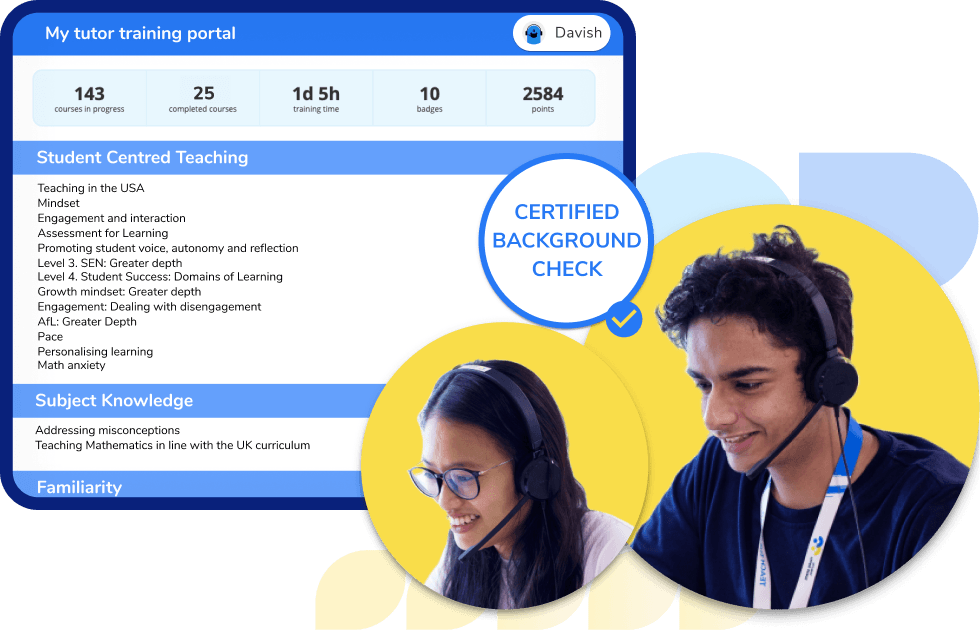
Selected tutors must then complete and pass our intensive initial tutor training program that covers:
- Understanding the curriculum and how students are assessed,
- Delivering student-centered teaching,
- Building rapport and personalizing lessons to age and ability,
- Using effective assessments for learning techniques,
- Identifying and addressing misconceptions,
- Fostering a growth mindset and promoting student centered learning, student voice, autonomy, and reflection,
- Dealing with disengaged students,
- Using lesson content to adapt pace,
- Supporting students with math anxiety,
- Successfully evaluating sessions, and
- Understanding safeguarding policies and promoting student wellbeing.
Once tutors begin working with students, tutors receive regular evaluations and feedback to continuously improve in their tutoring.
Read more: The Secret to Effective In-School Tutoring: The Quality and Training of Your Tutors
Tutoring can be an effective way to improve math skills and academic success if your tutoring approach prioritizes research-based tutoring strategies to boost learning and motivation.
Non-specialist teachers and staff can deliver effective tutoring, but the best tutors will be subject specialists with training and experience in using tutoring strategies to support learners. Therefore, effective and thorough tutor training is key to successful tutoring.
Read more:
Tutoring strategies FAQs
High-quality tutors must have content knowledge and the ability to engage tutees in learning using various tutoring strategies. They must also be able to engage students through questioning that gives the tutor feedback on what the tutee is learning, while the student is an active learner.
Tutoring should follow a structure that allows tutors to review content, introduce and practice new content, and assess learning. One efficient lesson structure is:
1) Review and practice mastered skills
2) Teach and model the new concept
3) Model teacher-led practice with the new concept
4) Independent practice of the skill taught
If students are finding it difficult to work with tutors, it’s important to prioritize developing positive relationships and establishing a supportive learning environment. Tutors can learn what the student likes, their interests and hobbies and learning preferences and tailor tutoring sessions to their individual preferences and needs. It’s also important to set and share tutoring goals to make the tutoring sessions meaningful.
Do you have students who need extra support in math?
Give your students more opportunities to consolidate learning and practice skills through personalized math tutoring with their own dedicated online math tutor.
Each student receives differentiated instruction designed to close their individual learning gaps, and scaffolded learning ensures every student learns at the right pace. Lessons are aligned with your state’s standards and assessments, plus you’ll receive regular reports every step of the way.
Personalized one-on-one math tutoring programs are available for:
– 2nd grade tutoring
– 3rd grade tutoring
– 4th grade tutoring
– 5th grade tutoring
– 6th grade tutoring
– 7th grade tutoring
– 8th grade tutoring
Why not learn more about how it works?





